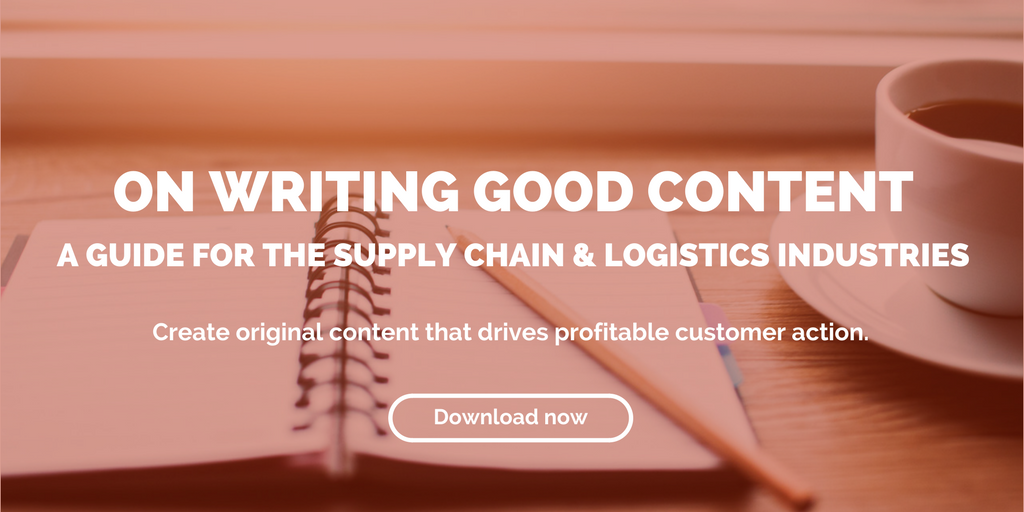
by Fronetics | May 9, 2019 | Blog, Content Marketing, Logistics, Manufacturing & Distribution, Marketing, Supply Chain
Putting your audience’s informational needs first when publishing blog content is the only way to guarantee success in the modern marketing landscape.
Highlights:
- Audiences are increasingly ignoring promotional messaging.
- Buyers are seeking value from vendors outside the sales funnel.
- Information is your best asset — publish what you know.
The latest industry research from the Content Marketing Institute indicates that nearly all (90%) of the most successful B2B content marketers have one thing in common: they prioritize their audience’s informational needs over their sales/promotional message. And that’s compared with only 56% of the least successful B2B content marketers.
Materials-handling marketers should take note when making decisions about publishing blog content. We see companies in this sector making this mistake all the time. They want to fill their blogs with information about their products. But to achieve success in today’s B2B purchasing landscape, you need to be prioritizing your audience’s needs over promotional messaging.
Sales pitches get ignored
A large reason for shifting focus is because audiences are increasingly tuning out sales pitches. This generation of buyers has been heavily marketed to their entire lives, and they don’t hesitate to swipe left at the slightest hint of someone trying to sell them something.
[bctt tweet=”This generation of buyers has been heavily marketed to their entire lives, and they don’t hesitate to swipe left at the slightest hint of someone trying to sell them something. ” username=”Fronetics”]
Think for a moment about your own personal experiences with email, social media, and even phone calls. The truth is, most of us tune out overt sales pitches, either hitting delete or scrolling past them. We’ve moved beyond a time when marketing is about pushing your products.
Your blog, therefore, should not be another channel for selling. But, what kinds of information should you publish?
Provide value by putting customer needs first
The answer is actually quite simple. What information or expertise do your buyers want? Your most valuable commodity is your unique understanding of the challenges your audience faces. If you begin publishing blog content that answers their questions, they’ll be more likely to find you, remember you, and become your customer.
As you think about publishing blog content, take a step back and think about the questions your buyers ask, either of you, on social media, or elsewhere. Examine industry publications to determine the challenges faced by your target buyer persona.
Does your content answer those questions? Does it offer value in and of itself? And does it inform your audience about how you are there to help them? If the answer to these questions is yes, then you’re taking the right steps toward materials-handling marketing with today’s B2B buyers.
Related posts:


by Fronetics | Jun 6, 2016 | Blog, Content Marketing, Marketing, Strategy

Trying to pass your sales pitch off as content will only hurt your content marketing efforts.
Think your blog is a refreshing new way to highlight your products or services? Do your posts include verbiage like “one-stop-shopping,” “innovative,” or “industry leader?” Stop right there. Everyone you reach probably knows right away that you are trying to sell them something, and they will quickly move on.
As counterintuitive as it may sound, being “salesy” will make potential customers look elsewhere, or run in the opposite direction — perhaps to your competition. The best way to win customers is to stop boasting about yourself and to stop trying to sell. Content that answers your customer’s needs is what will grow your business.
Nobody welcomes a sales pitch
Admit it: you tune out anyone that comes across as trying to sell you something. You get emails, voicemails, and social media updates with “information” that is really a not-so-cleverly disguised sales pitch. What do you do? Most likely you hit delete, or you do not read past the first sign of a sales promotion.
So you know deep down that “salesy” does not sell. Yet, according to a recent study of 500 global marketers from the Economist Group, many B2B content marketing programs are doing just that: promoting products throughout their content efforts. In fact, 93% of the marketers surveyed said they directly connect content to a specific product or service.
Customers see right through this trick. The same study found the majority of B2B customers are annoyed by pitches. In fact, 71% of B2B executives reported that content they didn’t like seemed more like a sales pitch than valuable information.
Focus on your customers to increase sales
So what should you content be doing? Rather than forcing your products on your prospective customers, take time to answer their questions. Be the expert advice they are seeking. You do this by:
- Keeping content informative and educational. Your content should hold value for your readers.
- Letting your content demonstrate market expertise. It should give the reader a favorable impression of you and your business. They should walk away thinking that you know what you are talking about.
- Write as if you are speaking to a business peer. You are approachable and intelligent. Speak the language of the customer, and bring something new to the table, in terms of information.
- Focus on topics and questions of crucial importance to your target audience. What do they care about or want to know more about?
The philosophy of content marketing is to offer help, to educate, and, at times, to entertain your target audience. This is accomplished by focusing on the customers’ needs and interests, not your company’s latest product. When you form this online relationship with your audience, you gain their trust and respect, and that is what brings in sales.
Related posts:


by Fronetics | Sep 4, 2014 | Blog, Marketing, Supply Chain

The temptation is obvious: You want to use your business blog to proclaim the virtues of your excellent products. You throw around words like “unique,” “outstanding,” “robust,” and “industry-leading.”
Perhaps you even add a blinking “Buy Now!” button at the end, convinced your reader simply can’t resist hitting it.
There is only one problem: Your sales pitch made your prospective customer tune out long before they reached the last paragraph.
Imagine the following scenario: You enter a car dealership and are greeted by an enthusiastic sales agent, grinning ear to ear. He launches into his pitch about mega sales and the best deal of the century. Any question from you is brushed aside as he has more to say about the car model that he has decided you must have. Turned off by his sales strategy, you make a quick exit.
Or think of another example: A sales representative from a company whose website you browsed a few days ago follows up with a call and leaves a voice mail. The message is friendly. She does her best not to sound pushy. She introduces her “leading” company, which offers “a wide range of services” and a “one-stop-shop” for all your needs. By the time she reaches, “I look forward to meeting you,” you’re still ready to hit the delete button. Again, the voice mail was loaded with sales lingo.
As strange as it may sound, being “salesy” is bad for business. HubSpot, a marketing consulting service and software developer, goes as far as calling it one of the “7 Deadly Sins of Inbound Marketing.”
It reads:
Sin 3: Gluttony – Don’t be gluttonous and stuff your content with information about your company products. Focus on solving problems and helping your customers and community first and not jamming your product pitch down their throats.
Let’s go back to the two examples above and transfer the line of thought to your blog. Rather than forcing your products on your prospective customers, take time to answer their questions. You are there for them. They may be in the beginning of their buyer’s journey and far from ready to sign off on a brand new car. Perhaps they entered that dealership to browse, to check out the view behind the steering wheel.
And what if that voice mail had been phrased differently? What if the sales representative had spent a moment talking about what your browsing history said about the problems you’re seeking solutions to and presented some real-life proof of how her company could help? Basically, she would have been more effective showing how her company can deliver value to you. The same goes for your blog.
Here’s what you should do:
- Stay informative and educational.
- Demonstrate market expertise.
- Sound like a business peer.
- Focus on topics and questions of crucial importance to your target audience.
The bottom line: If you want to make a sale, stop selling.





